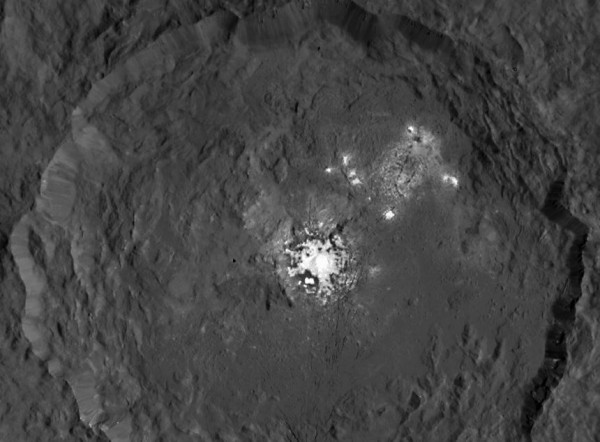1 Ceres was the first asteroid to be discovered, in the year 1801. That makes sense because it’s the largest body orbiting between Mars and Jupiter. The word asteroid means starlike, and until recently we saw asteroids only as starry points in our sky, which moved apart from the true stars and so revealed themselves as members of our solar system. Now, thanks to Earth-based radar observations of close-passing asteroids and to spacecraft, we know some of these bodies as individual worlds, and Ceres in particular – now categorized as a dwarf planet – has been orbited since March 2015 by the Dawn spacecraft. We’ve now seen it from various orbital distances, in all sorts of configurations of light and shadow. On April 29, 2017, thanks to careful maneuvering by Dawn mission specialists, Dawn was exactly between Ceres and the sun, in a position called opposition by astronomers, when it acquired the images needed to make the movie above. From this position, the spacecraft looked down on a fully illuminated Occator Crater, containing Ceres’ famous bright spots.
In this movie, the contrast is enhanced to highlight brightness differences. That’s why the Ceres bright spots stand out particularly well on an otherwise relatively bland surface. Dawn took these images from an altitude of about 12,000 miles (20,000 km). NASA explained:
Based on data from ground-based telescopes and spacecraft that previously viewed planetary bodies at opposition, scientists correctly predicted that Ceres would appear brighter from this opposition configuration. This increase in brightness, or ‘surge,’ relates the size of the grains of material on the surface, as well as the porosity of those materials. The science motivation for performing these observations is further explained in the March issue of the Dawn Journal blog.
Dawn’s observations of Ceres during its more than two years there cover a broader range of illumination angles than almost any body in the solar system. This provides scientists with an opportunity to gain new insights into the surface properties. They are currently analyzing the new data.
The new observations and images were largely unaffected by the loss of function of Dawn’s third reaction wheel. The spacecraft is healthy and orients itself using its hydrazine thrusters.


As a side note, Ceres is expected to remain in orbit around Ceres perpetually, even after it goes silent from our earthly perspective, becoming a more or less permanent (if anything can be said to be permanent) artificial moon of this world.
Another side note … dwarf planet Ceres regularly reaches opposition from Earth, too, and at such times, this little world is closest to us and in our sky all night. Ceres comes to opposition from Earth every 1,680 days. It’ll reach opposition in our sky next on February 1, 2018.
Enjoying EarthSky so far? Sign up for our free daily newsletter today!

Bottom line: The Dawn spacecraft was placed into a special orbit, so that it could view dwarf planet Ceres’ famous bright spots from a position known to astronomers as opposition.











